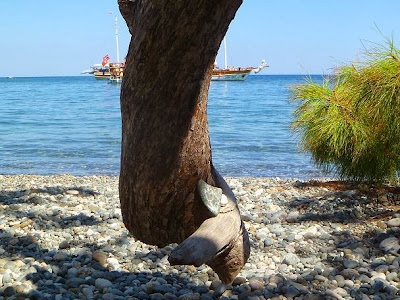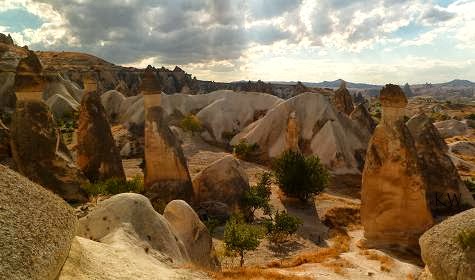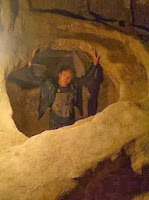With Jake and Dinos Chapman’s exhibit The Sum of All Evil showing in Hong Kong and recent events in Kenya, I’ve taken this opportunity to reflect back on a piece I wrote following yet another school massacre in the US .. I’ve updated something I hadn’t posted – but now I just want to rid myself of some feelings so I can continue to earn peace with my own condition in this world .. because it is Thanksgiving in America, perhaps those who give thanks should ask themselves why they feel it necessary to kill and eat animals by the million to express that sense of gratitude ...
I love food, I love to cook it, serve it to my friends, and eat it. A weekly trip to the local market is a vibrant experience that helps connect me to the local community. I love to discover new foods and ways to prepare meals, and sharing with others around the dining table makes it an even greater joy. Thanksgiving in America is a time for families and friends to remember reasons to be grateful for the lifestyle they have today. It is an occasion when food is the centre of a community gathering to share the love of our connections to each other.
Unfortunately, these days most people don’t have time to reflect upon the traditions and comfort that food brings to life, hurrying as we are between schools and jobs and other obligations, squeezing a quick trolley run around the hypermarket into the busy week. Somewhere in that hustle and shuffle we are losing the connection to the land that feeds us, as food has become big business rather than a way to bond with family and friends in a delicious celebration of living.
 Do you ever think about how
that food arrives in the supermarket to grace your dinner plate? How it gets
from the farm to your house? Are you aware how few family farms now exist in
relation to a hundred, or 50 or even 20 years ago? Did you know that a few
global corporations are buying the rights to food production and patenting the
seeds that grow your food, so that farmers are no longer allowed to plant
vegetables without their permission? How can we allow a few people to control
to the agriculture of the world?
Do you ever think about how
that food arrives in the supermarket to grace your dinner plate? How it gets
from the farm to your house? Are you aware how few family farms now exist in
relation to a hundred, or 50 or even 20 years ago? Did you know that a few
global corporations are buying the rights to food production and patenting the
seeds that grow your food, so that farmers are no longer allowed to plant
vegetables without their permission? How can we allow a few people to control
to the agriculture of the world?How can we continue to allow weapons manufacturers to control the future of our children? Why don’t these people who collect and use these tools recognise the incongruence between the free access to weapons and everyone else’s security? Is their pursuit of happiness, through killing or having the ability to kill, more valuable than the life and liberty of others?
Why do we choose to accept the decisions of those who would lead us into war, or who continue to sell off the valuable natural resources that we are all dependent upon? Who decided these people were best qualified to lead nations and determine the future course of humankind (don't throw democracy at me - there are statistics to prove that 'most people' didn't vote them into power)? How can the system change to benefit the majority rather than a handful of speculators on the value of our inheritance?
So many questions, and the answers are lost in the confusion of personal interest and greed. Even when those politicians trot out heartfelt and sympathetic concern for the latest victims of liberal gun laws there is an insincerity lurking behind the choice of words in their speeches. When politicians suggest we must do more to protect our children, and ‘we must change’, he or she is really saying we should have more security in schools rather than we must change the actual gun laws. They mean we must have more paperwork before these rapid-fire automatic-reload machine guns are sold at gun fairs.
They mean, ‘we’ the authorities, will continue to be bought and paid for by various lobby groups to continue the manufacture and distribution of weapons to be unloaded on a media manipulated, culturally and socially anesthetized public. And, of course, the old argument of the gun lobbyists, that a free nation retains its independence by having a secure right to protect themselves from over-intrusive government, is pure nonsense.
If lawmakers were to say, “Okay, everyone must hand over any gun not specifically designed for self-defense or hunting,” who is going to be the first to turn their weapons against government agents rather than hand them over? Because in that scenario you won’t be protecting anything, you will be the aggressor, an enemy of the people, you will be shot down, and the media will be quick to splatter your image across the airwaves with the timelessly enduring label 'psycho'.
 A shame, but time will
witness deadly results to the way ‘we’ have allowed this unabated proliferation of deadly
weapons to people who want a personal killing tool.
A shame, but time will
witness deadly results to the way ‘we’ have allowed this unabated proliferation of deadly
weapons to people who want a personal killing tool.Time after time it has been shown that though words are spoken no action will hinder the production and sale of these instruments of death; if this continues, the future will be a frightening place indeed.
I believe that apathy to these acts of violence begins on our dinner plate.
These issues are related, because without the blood-soaked industry of live food production, which in itself is a further cause of deforestation (to provide feed and grazing land for meat producing animals such as cows), ordinary people would have greater access to resource rich lands to plant crops and establish farms without need for genetically modified seeds to induce larger yields. The infiltration of corporate seed manufacturers into the organic marketplace has created a deadly reliance on these patented genetically modified organisms which will come back to haunt us in future generations, and slowly (regardless of recent European legislation) these altered seeds and pesticide-dependent plants are insinuating their way into your kitchen.
Some of my students over the past year have been agricultural engineers, as this region, with its rich soil and excellent climate, is a veritable cornucopia of food production. I’ve been told many stories of the work they are involved with in the thousands of acres of experimental greenhouse plants. The major producer of patented varieties of seed, Monsanto, sends annual supplies of their newest strains to be tested for compatibility with the soil and sunlight and growing techniques, and these engineers observe and analyse the results. The most suitable varieties are then passed on to the farmers, eventually to end up on your dining table.
Every year the farmers must buy new seeds because the only seeds they are now allowed to buy have been genetically modified not to reproduce naturally. Larger, perfectly uniform red peppers and square watermelons may be aesthetically eye-pleasing, but what purpose do they serve other than making them easier to stack?
Naturally grown and naturally reproduced vegetables taste fresher and are healthier, being filled with more nutrients than these generic, modified organisms, so why do we accept these substitute foods? When did we begin to place greater value on the way things look over taste and our health? At what point did the image of a squash become more important than its direct nutritional benefits? Like a scene from the film Soylent Green we now can watch on media channels the process of turning chickens, if one can call a beakless, legless, featherless life form a chicken, into sandwich filler, and the confinement of young animals to tiny cells in order to boost production; yet still the world consumes these bizarre and unnatural foodstuffs.
Daily I see media images of children who live in and around garbage dumps, who swim in waters clogged with plastic and paper waste, who play in the residue of chemical plants, and it disturbs me to realise that while these children, victims of war and corporate greed, are foraging amongst the discarded detritus of modern lifestyles, most people in the West have become impervious to the discrepancy arising from a very real and yet contemporary technological disparity and disproportionate access to opportunities for betterment.
 If these wars were really a
battle to improve the lives of these innocent children then perhaps within
debate their ends could justify them. If patented food was being used to feed
them it could be argued that we are developing more efficient production to
service a growing population. However, what we see is continued economic gain
for the few and a downward spiral of disillusionment, despair, disease and
death for many.
If these wars were really a
battle to improve the lives of these innocent children then perhaps within
debate their ends could justify them. If patented food was being used to feed
them it could be argued that we are developing more efficient production to
service a growing population. However, what we see is continued economic gain
for the few and a downward spiral of disillusionment, despair, disease and
death for many.We continue to splatter the big screen of the cinema with images of graphic gratuitous violence and murder and pay to see these blood fests thrown into the popular culture with random abandon for the connection with and consequences of real life. And yes, there is a difference between an ancient Greek tragedy wherein someone is killed by the sword and contemporary cinematic gun battles – there is no moral imperative or punishment in the arbitrary killing of today. Why did he do it? No one knows and no one cares. So, life intercedes and ‘life imitates art more than art imitates life’, to quote Oscar Wilde.
There are many reasons why these things happen, but the first thing to be done is to remove all the weapons from all people, everywhere. That means all firearms removed from all people. The manufacture and distribution of weapons must be stopped to move forward socially, spiritually and humanely.
Then, acknowledging the harm of violence that contemporary culture has embraced, perhaps we can rid ourselves of the mistaken belief that humans need protein from dead animals to survive healthily. Violence toward animals, in the form of captive consumption, is the root of deathly pursuits – for if we accept killing on the vast factory scale we have embraced today, then by extension we can easily accept the killing of other forms of life. We have become immune to torture and death, we have become anaesthetised to pain and suffering, we delight in the results of this fatal parade of blood-based food. Eating the flesh of mammals like ourselves prepares us to kill. Refraining from this deadly activity opens our minds and hearts to the realisation that we all share basic characteristics of life.
Once the weapons are gone, we can try to recognise what is in our minds; that our spiritual connection with the earth is essential to maintain life on the planet. Then we can act with justice in liberty to free ourselves from these bonds of insanity to discover the roots of truth and apply those principles in our daily life.
As the sun dips behind the mountains that line the coast and sets over the warm, blue sea I consider my options, and realise there are changes to be made in my life too. As I prepare for the next step on my own path, a path that is taking me closer to my home, I hope that others will find within themselves a spark of realisation that we shouldn’t continue to consume and destroy everything in our path simply because we can; having the ability to do something doesn’t mean it’s the best or right thing to do.
As I prepare to move on to destinations new, my prayer of hope is with those who suffer at the hands of these industries, these fanatics and these stubborn fools, anywhere and everywhere. Let’s begin the change to a better world by recognising our place in the process of distribution of death and the part we can play in stopping this madness. If we are to have a reason to give thanks in the future, then surely “we must change” .. indeed! Many Thanks.
* * *





















































